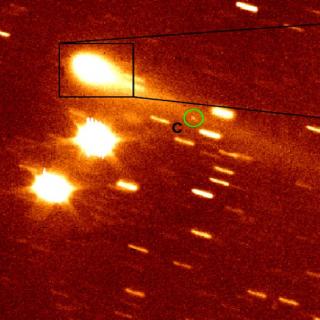Bibcode
Ortiz, J. L.; Kretlow, M.; Schnabel, C.; Morales, N.; Flores-Martín, J.; Sánchez González, M.; Casarramona, F.; Selva, A.; Perelló, C.; Román-Reche, A.; Alonso, S.; Rizos, J. L.; Gonçalves, R.; Castillo, A.; Madiedo, J. M.; Martínez Sánchez, P.; Fernández Andújar, J. M.; Maestre, J. L.; Smith, E.; Gil, M.; Pelenjow, V.; Moral Soriano, S.; Martí, J.; Luque-Escamilla, P. L.; Casas, R.; Delgado Casal, J.; Rovira, J.; Aceituno, F. J.; Dekert, V.; Farfan, R. G.; de Ory Guimerá, V.; Serrano Estepa, J.; Jehin, E.; Ferrais, M.; Alarcon, M. R.; Licandro, J.; Serra-Ricart, M.; Gutiérrez, P. J.; Kilic, Y.; Leiva, R.; Santos-Sanz, P.; Duffard, R.; Fernández-Valenzuela, E.; Vara-Lubiano, M.; Alvarez-Candal, A.; Rommel, F. L.
Bibliographical reference
Monthly Notices of the Royal Astronomical Society
Advertised on:
2
2024
Citations
2
Refereed citations
1
Description
On 2023 December 12, the star α Orionis will be occulted by asteroid (319) Leona. This represents an extraordinary and unique opportunity to analyse the brightness distribution of Betelgeuse's photosphere with extreme angular resolution by studying light curves from different points on Earth and at different wavelengths. Here we present observations of another occultation by asteroid Leona, on 2023 September 13, whose goal was to determine Leona's projected shape and size in preparation for the December 12th event and its interpretation. The occultation campaign was highly successful with 25 positive detections from 17 different sites and a near miss. The effective diameter in projected area derived from the positive detections was 66 ± 2 km using an elliptical fit to the instantaneous limb. The body is highly elongated, with dimensions of 79.6 ± 2.2 km × 54.8 ± 1.3 km in its long and short axis, respectively, at occultation time. This result, in combination with dense time series photometry of Leona that we recently obtained, together with archival sparse photometry, allowed us to predict the angular size of the asteroid for the Betelgeuse event and to simulate the expected brightness change. Also, an accurate position coming from the occultation is provided, to improve the orbit of Leona.
Related projects

Minor Bodies of the Solar System
This project studies the physical and compositional properties of the so-called minor bodies of the Solar System, that includes asteroids, icy objects, and comets. Of special interest are the trans-neptunian objects (TNOs), including those considered the most distant objects detected so far (Extreme-TNOs or ETNOs); the comets and the comet-asteroid
Julia de
León Cruz